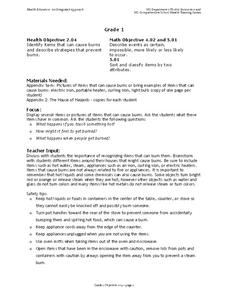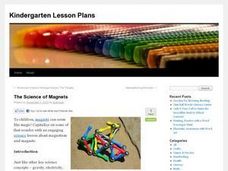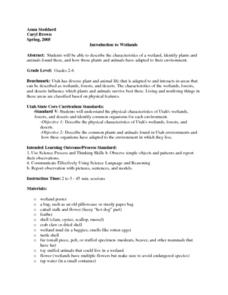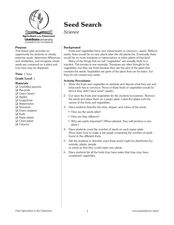Curated OER
Body Parts
In this interactive human biology instructional activity, learners read ten riddles about body parts and type in the appropriate name of the body part the riddle is describing. Students also answer a nine word crossword puzzle that...
Curated OER
Fossil History
Students examine the similarities and differences between living organisms and fossils. In this fossil lesson students reenact the process of creating a fossil.
Curated OER
2005 Submarine Ring of Fire Expedition: Unexplored
Young scholars compare and contrast submarine volcanoes at convergent and divergent plate boundaries, infer kinds of living organisms that may be found around hydrothermal vents, and describe ways in which scientists may prepare to...
Curated OER
Air and Water in the Environment
Students demonstrate an awareness of air as a substance that surrounds us and takes up space, and whose movement we feel as wind. They predict and describe how local weather conditions affect living things, including themselves.
Curated OER
What Is It?
Play the game of Tag and differentiate between plants and animals. Explore the characteristics of plants. Identify the major parts of plants (e.g., seeds, stem, pistil) and describe their basic functions. Compare the requirements of some...
Curated OER
Living Sources of Weathering
In this sources of weathering worksheet, students read about the various things that cause weathering including plants and animals. They answer four critical thinking questions about weathering.
Curated OER
Burns
First graders classify and sort items into categories of things that can cause burns and not cause burns. In this burns lesson plan, the teacher facilitates a discussion of things that can burn students and not burn them. They then...
Curated OER
Color Poems
Students describe colors. In this descriptive writing lesson, students brainstorm color descriptions using all of the senses except sight. Students write poems including similes, sensory images, and interesting word choice. Examples are...
Curated OER
The Science of Magnets
Students are introduced to the concept of magnetism and investigate the properties of magnets. In this magnetism lesson, students identify a magnet then examine why certain things are attracted to magnets and some things are repelled by...
Curated OER
Introduction to Wetlands
Students describe the characteristics of a wetland, identify plants and animals found there, and how those plants and animals have adapted to their environment. They visit stations, view a video, and complete a KWL about the wetlands.
Curated OER
Adopt a Tree
First graders describe the characteristics of a tree. In this science lesson, 1st graders create predictions about a book they will be listening to, Have you Seen Trees. Additionally, students describe their trees using their 5 senses....
Curated OER
Oceanic Heat Budget Activities
Students map and research imaginary islands located in different parts of the world. They describe the weather and climate of their island and show how local currents, water temperatures and waves may influence the weather patterns.
Curated OER
Ecosystems of the World
Students are able to list different ecosystems and describe their environment and organisms. They have an understanding about the function and balance of the ecosystems. Students are able to tell what type of ecosystem the St. Mary's...
Curated OER
Science- Unit on Matter- Solids
Second graders identify and describe properties of matter.
They identify three forms of matter- solids, liquids, and gases with 100% accuracy. The student describes the properties of solid objects.
Curated OER
Circulatory and Respiratory Systems
Eighth graders are able to write a paragraph describing each system based on the information retrieved in class. They trace a route from Holly Springs, MS to Greenwood using the maps that they were given. Students discuss the role of...
Curated OER
Innovations in Elder Care
Students describe the symptoms and suspected causes of Alzheimer's disease or cancer. They describe current research projects seeking to learn more about or find treatments for either Alzheimer's disease or cancer. Students compare...
Curated OER
The Cube and Coin Challenges
Second graders participate in several games based on colored cubes and coins. They try to figure out the relative rate at which things happen and assess the concept of playing a fair game with their peers. Each student compare familiar...
Curated OER
My Favorite Room
Students practice describing a room. In this descriptive writing lesson plan, students use all of their five senses to describe their favorite room. The teacher will model for the class by creating a word list that describe the classroom...
Curated OER
Hear No Evil
Students explore the function of the ears. For this sense of hearing lesson, students read the book Polar Bear, Polar Bear What Do You Hear and discuss the things the Polar Bear heard. Students construct simple musical instruments and...
Curated OER
Seed Search
First graders examine seeds. For this fruits and vegetables lesson, 1st graders determine what fruits and vegetables have in common. Students cut open fruits and vegetables and examine their seeds. Students describe the sizes, shapes and...
Curated OER
Vocabulary Logs
Ninth graders illustrate words from their vocabulary logs. In this vocabulary lesson, 9th graders illustrate their vocabulary words and use them in a sentence. Students are encouraged to read their sentences aloud to the class and use...
Curated OER
Getting to Know You
Students explore ways in which they are smart. In this "getting to know you" classroom team building lesson, students discuss various ways people can be smart and describe ways in which they are smart. Students listen to "Smart" from...
Curated OER
Fable of the Fainting Goat
Second graders explore animal life by reading children stories in class. In this goat fable lesson, 2nd graders read several books which describe the different myths and folklore about goats. Students identify the needs of living animals...
Curated OER
"HOW I USE PLANTS" COLLAGE
Students create a collage that depicts the different ways they, as individuals, use plants. They describe ways in which humans use plants for food, shelter, and clothing and ways in which humans can protect natural areas to maintain...























